Abstract
1. The effects of magnetic brain stimulation on electromyographic (EMG) activity recorded from arm and hand muscles have been investigated in five infant and six adult macaque monkeys under ketamine sedation. 2. In the adults, brief, short-latency EMG responses could be readily evoked with magnetic stimuli of 40-50% of the maximum stimulator output (1.5 T). 3. In a cross-sectional study of five infant macaques, it was difficult to evoke EMG responses in young infants (less than 5 months old). Clear short-latency responses were first evoked in an animal 5.75 months old. This change was accompanied by an increase in the probability of occurrence of the responses. 4. In a longitudinal study of two infant monkeys over a period ranging from 2.5 to 14.5 months of age we found that clear short-latency responses were first evoked at 4 and at 5.5 months, respectively. In both animals there was a steady fall in response threshold which reached the adult range at 6.5 and 8 months, respectively. EMG responses in animals older than 8 months were indistinguishable from those in adults. 5. In the longitudinal study we also noted that the latency of EMG responses to magnetic brain stimulation declined with age. Since there were no comparable changes in the peripheral conduction time in these animals, we attribute this result to a decrease in central conduction time. 6. Parallel behavioural observations of the natural behaviour of the same animals within a colony indicated that mature precision movements of the fingers were not used until 5-6 months of age. 7. In two adult monkeys, the latency of EMG responses evoked in the extensor digitorum and first dorsal interosseous muscles by direct stimulation of the corticospinal tract, via electrodes implanted in the medullary pyramids, was found to be 0.7-1.7 ms shorter than that of responses evoked by magnetic stimuli. It is argued that at least the earliest component of these latter responses is conducted over the cortico-motoneuronal pathway. 8. The mechanisms likely to contribute to the late appearance of EMG responses to brain stimulation are discussed. One of these is probably the establishment of mature cortico-motoneuronal connections, which are not present at birth.
Full text
PDF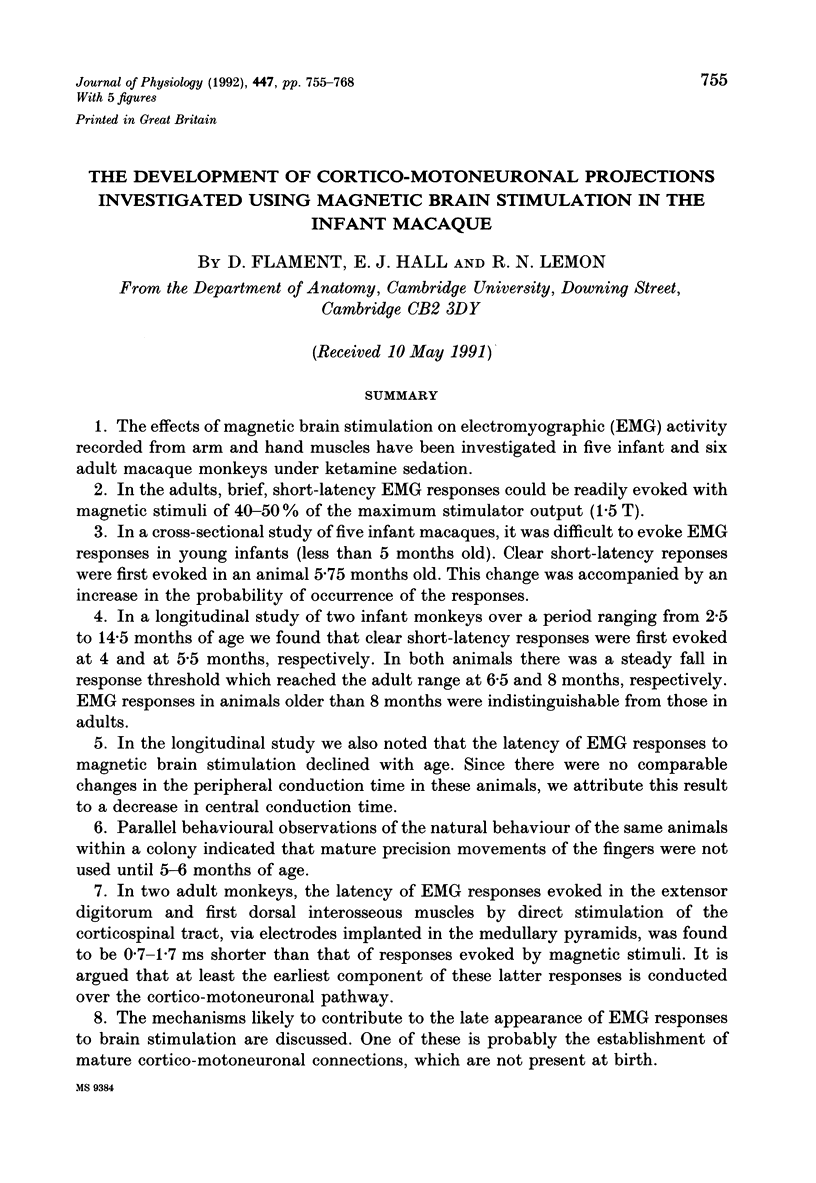
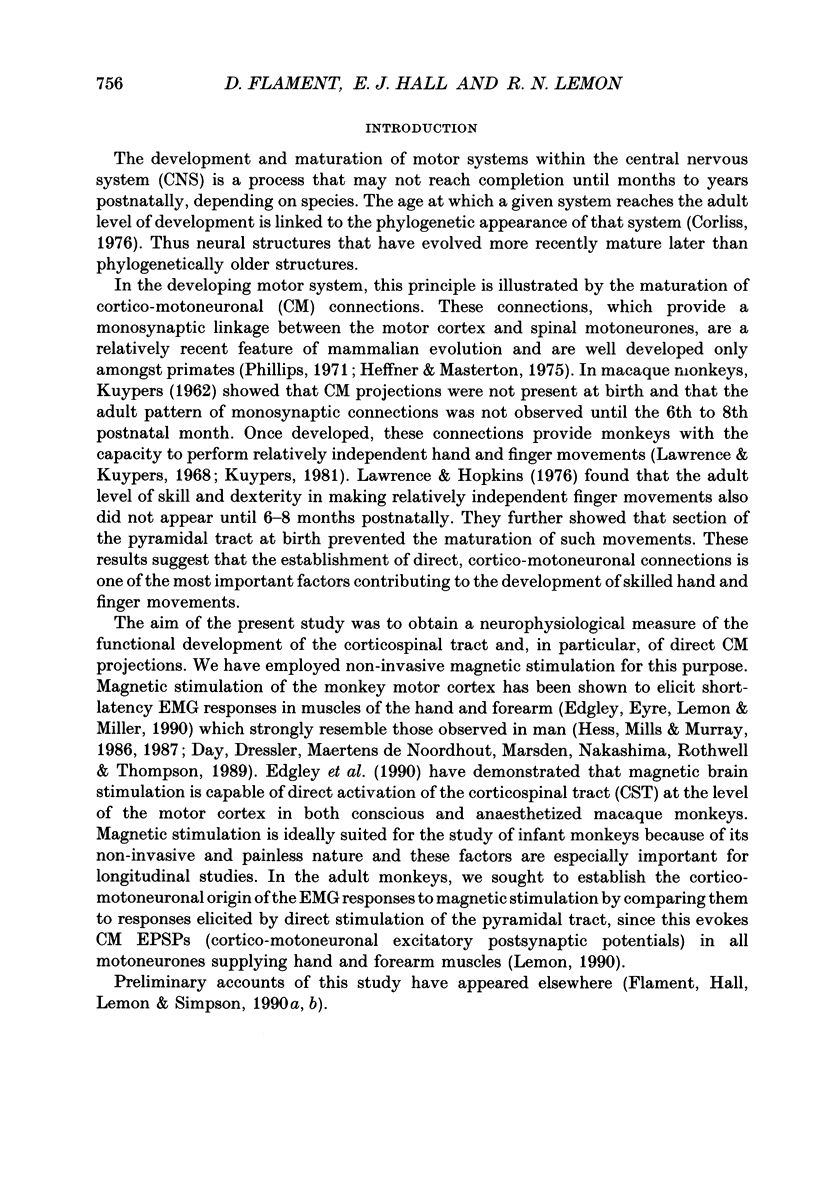

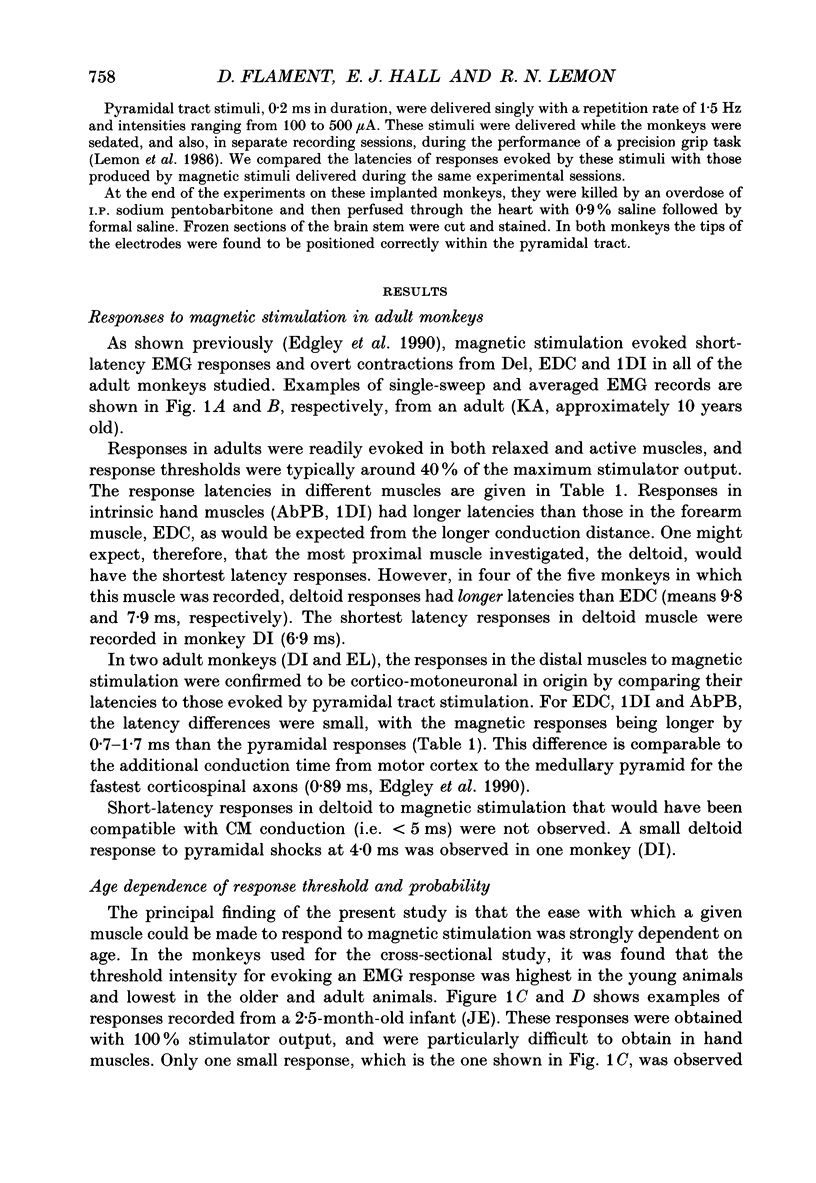

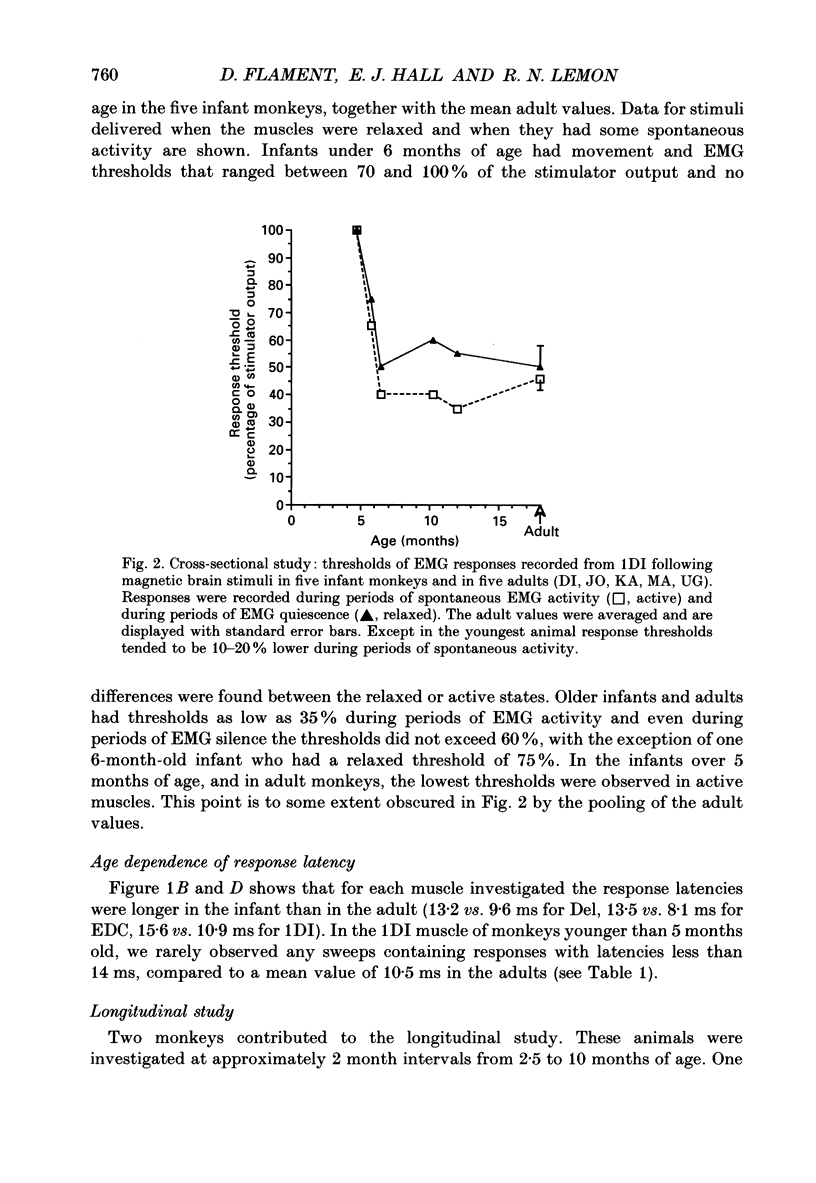
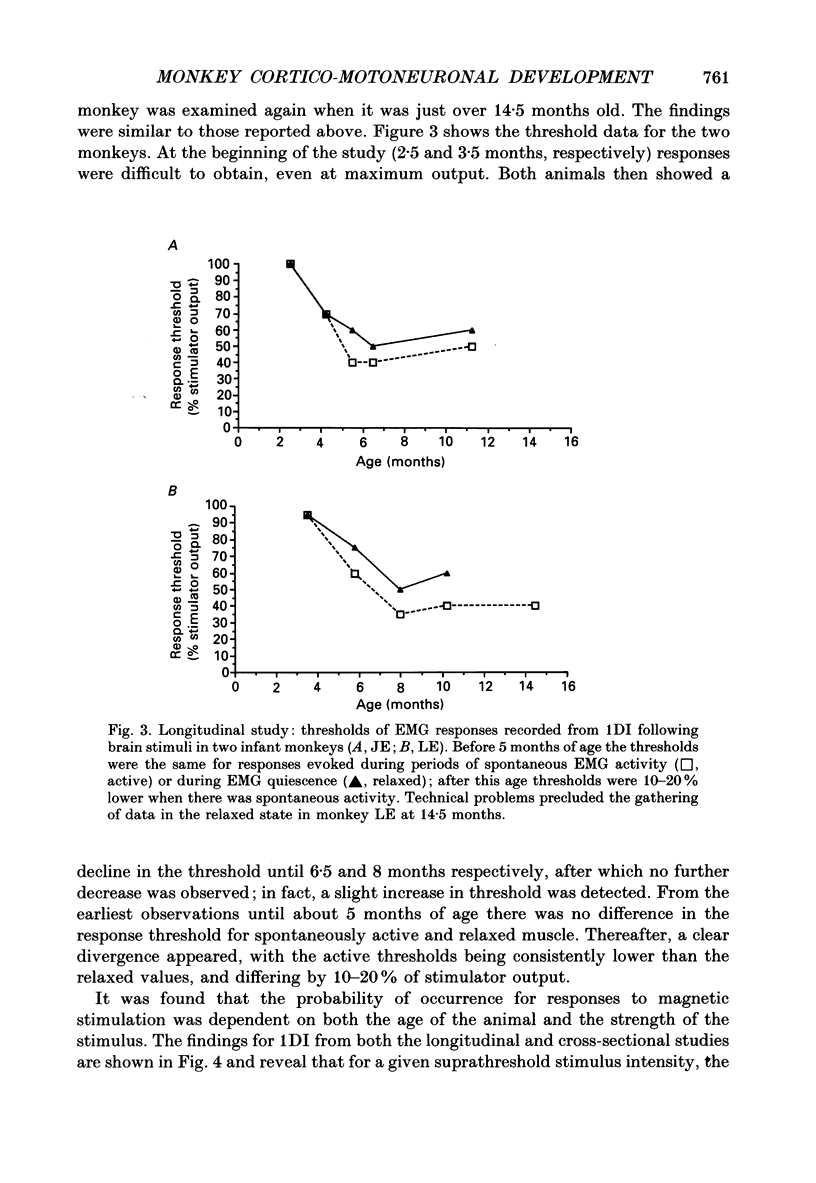

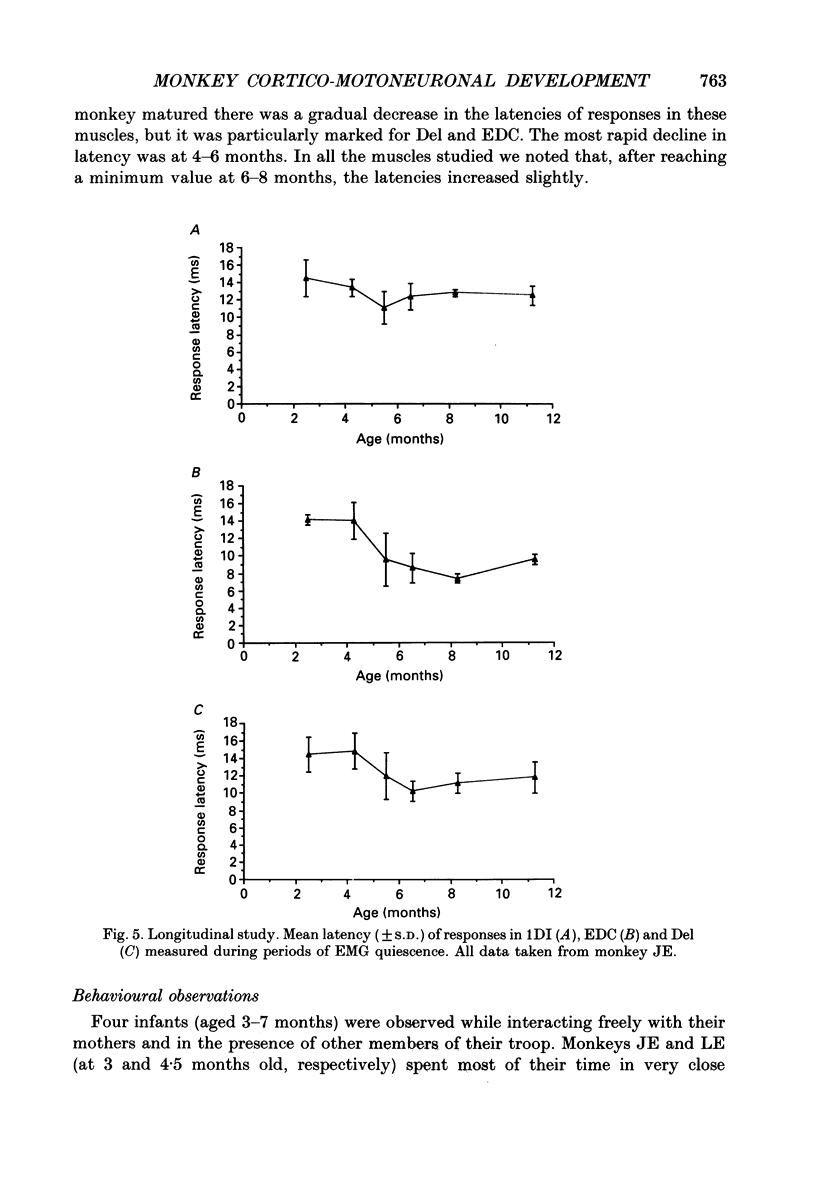
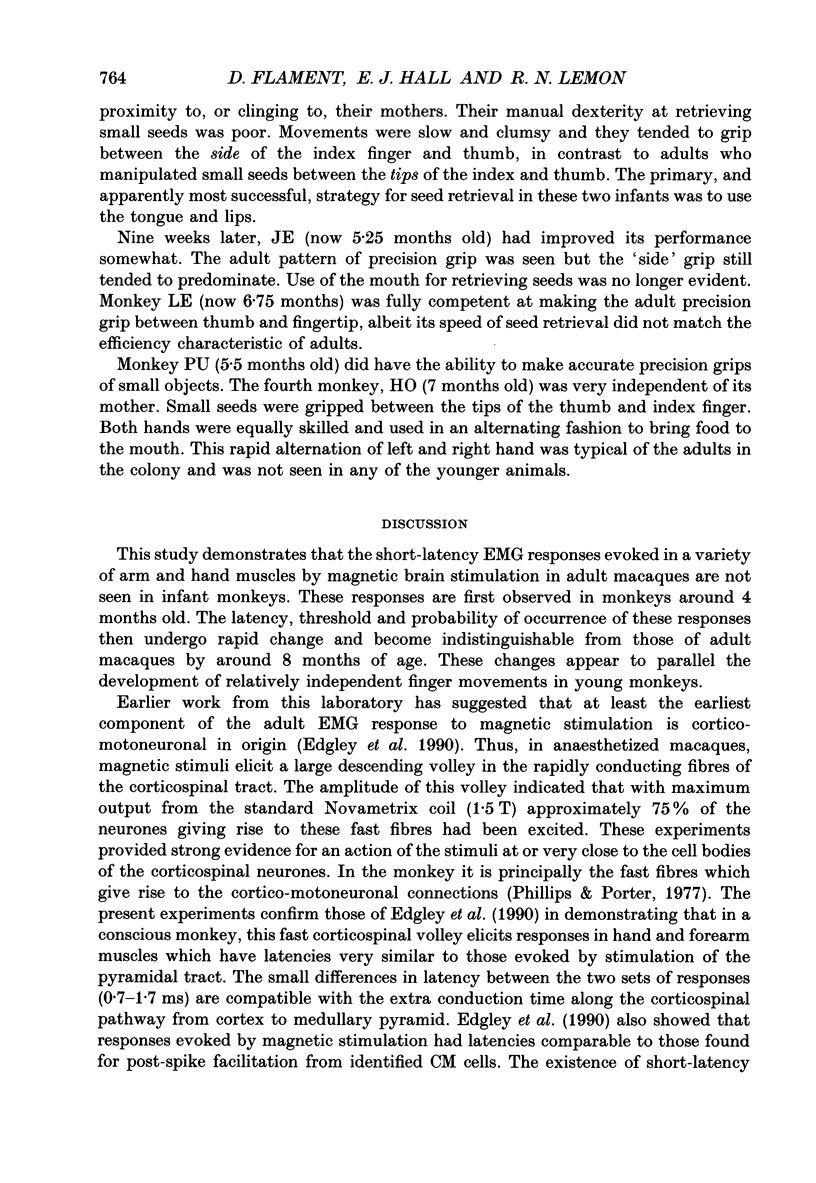
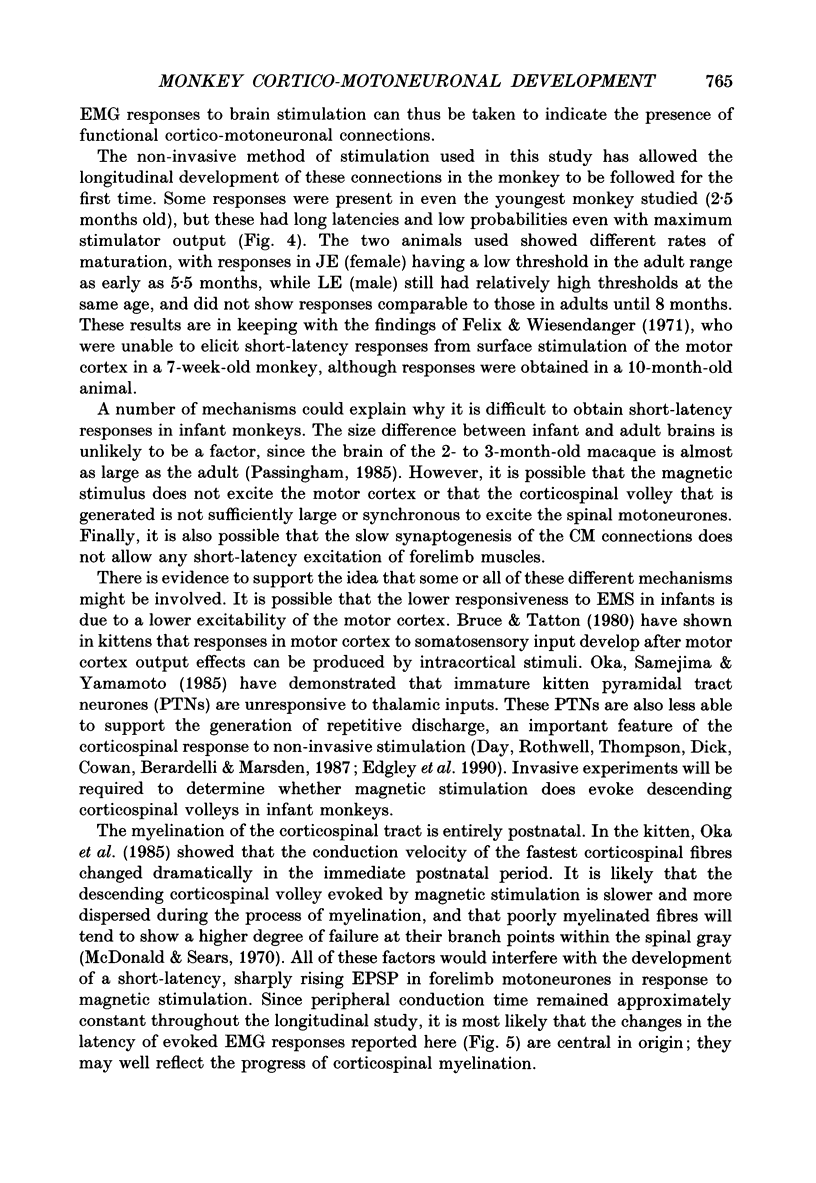
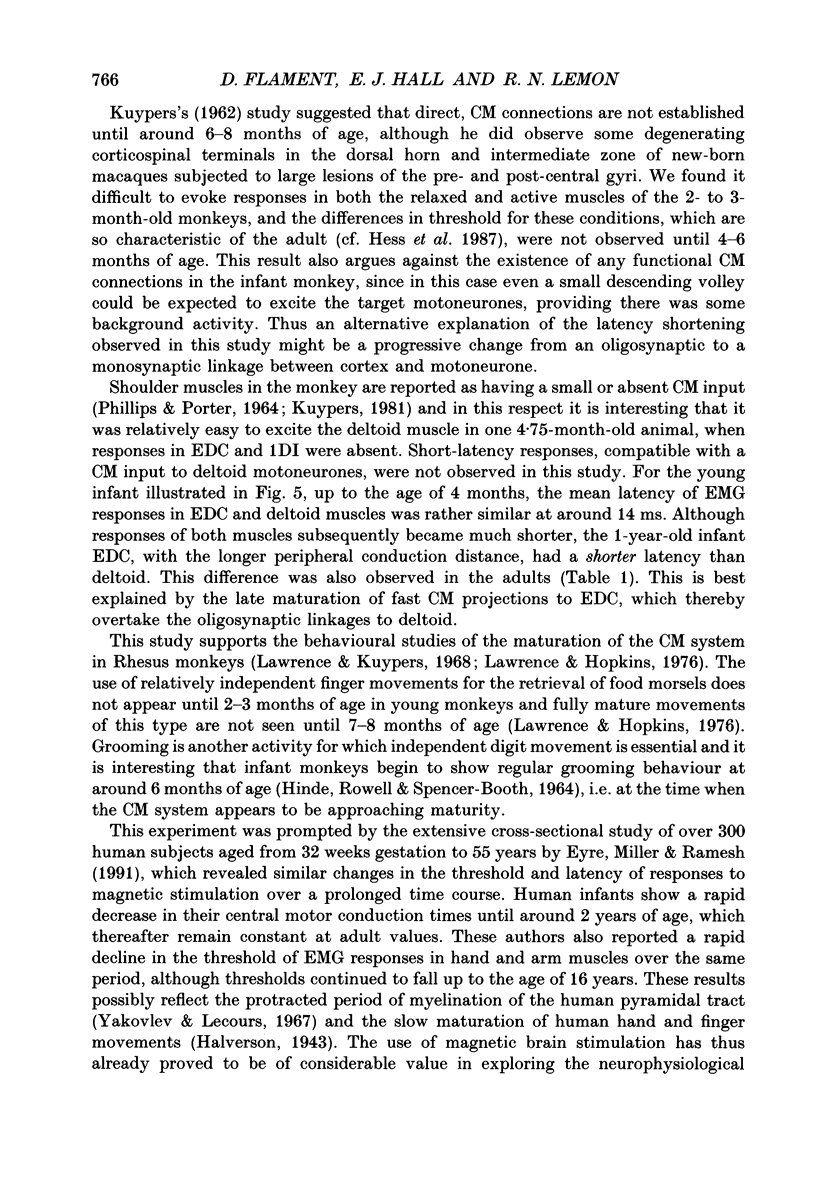
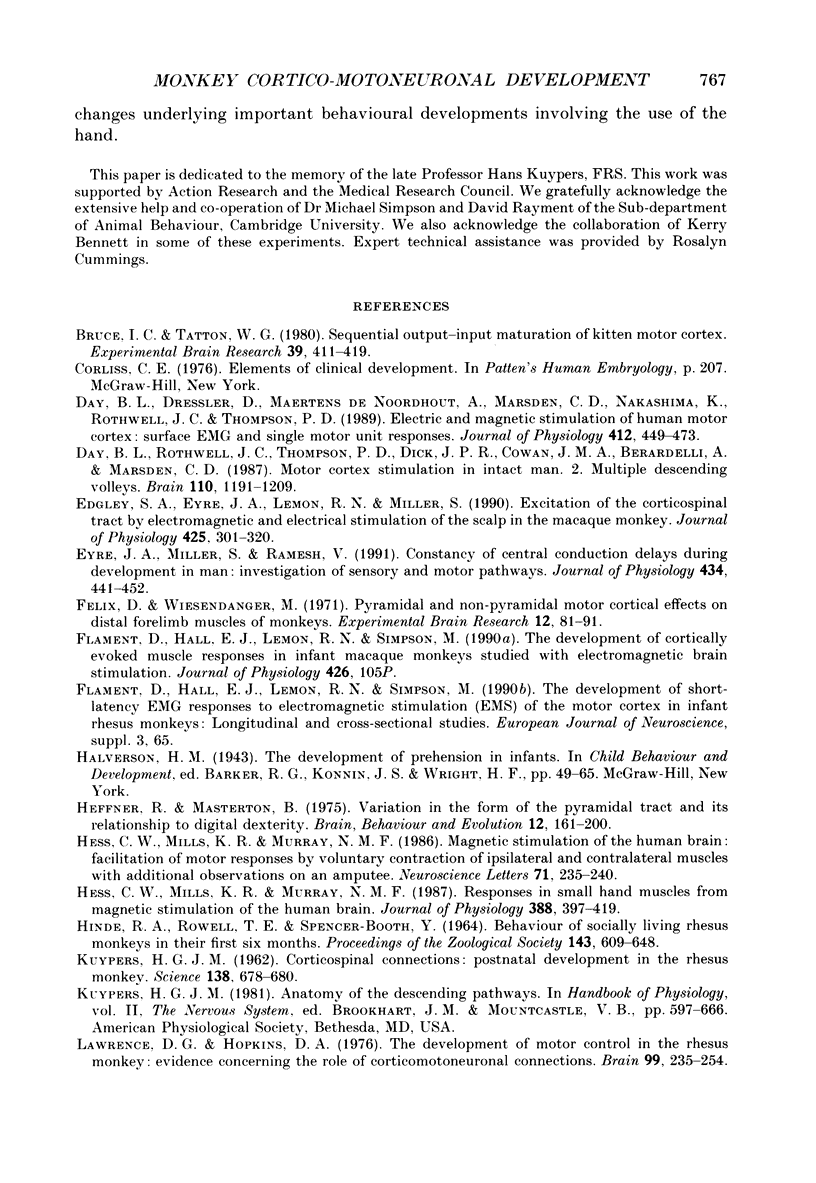
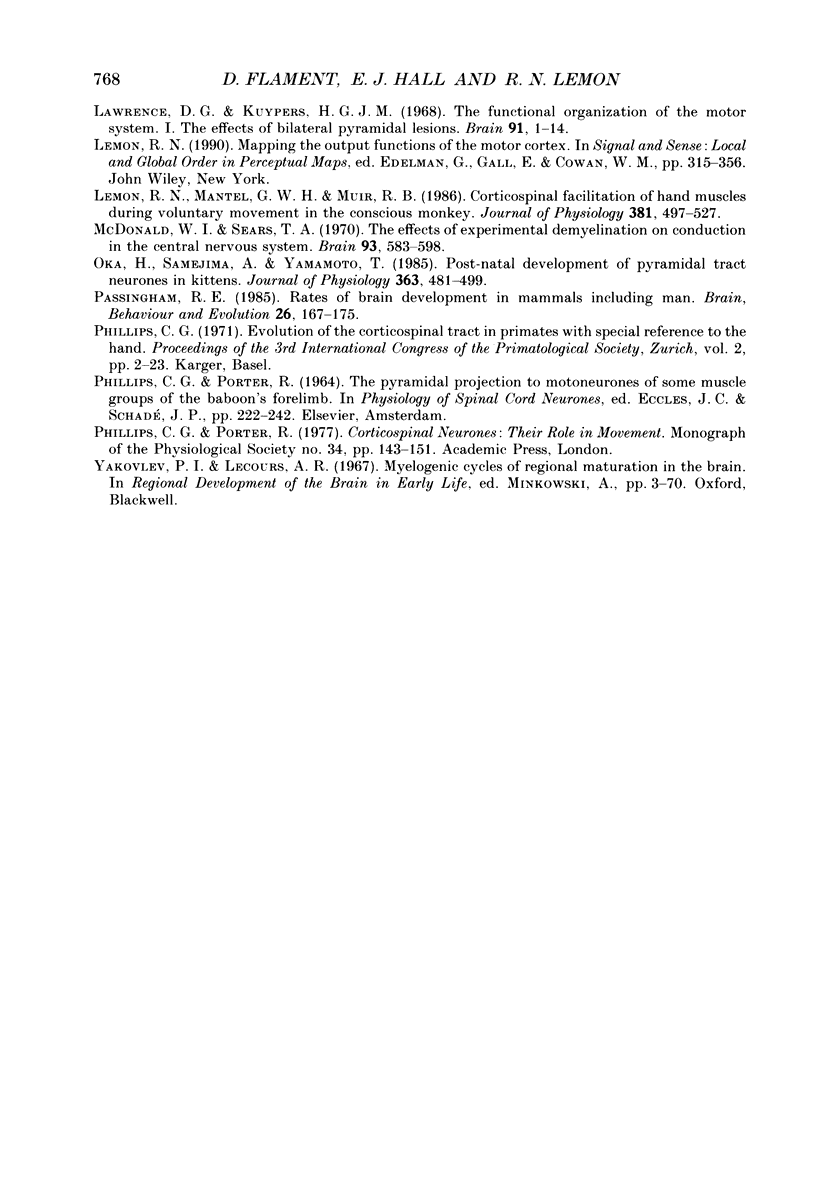
Selected References
These references are in PubMed. This may not be the complete list of references from this article.
- Bruce I. C., Tatton W. G. Sequential output-input maturation of kitten motor cortex. Exp Brain Res. 1980;39(4):411–419. doi: 10.1007/BF00239305. [DOI] [PubMed] [Google Scholar]
- Day B. L., Dressler D., Maertens de Noordhout A., Marsden C. D., Nakashima K., Rothwell J. C., Thompson P. D. Electric and magnetic stimulation of human motor cortex: surface EMG and single motor unit responses. J Physiol. 1989 May;412:449–473. doi: 10.1113/jphysiol.1989.sp017626. [DOI] [PMC free article] [PubMed] [Google Scholar]
- Day B. L., Rothwell J. C., Thompson P. D., Dick J. P., Cowan J. M., Berardelli A., Marsden C. D. Motor cortex stimulation in intact man. 2. Multiple descending volleys. Brain. 1987 Oct;110(Pt 5):1191–1209. doi: 10.1093/brain/110.5.1191. [DOI] [PubMed] [Google Scholar]
- Edgley S. A., Eyre J. A., Lemon R. N., Miller S. Excitation of the corticospinal tract by electromagnetic and electrical stimulation of the scalp in the macaque monkey. J Physiol. 1990 Jun;425:301–320. doi: 10.1113/jphysiol.1990.sp018104. [DOI] [PMC free article] [PubMed] [Google Scholar]
- Eyre J. A., Miller S., Ramesh V. Constancy of central conduction delays during development in man: investigation of motor and somatosensory pathways. J Physiol. 1991 Mar;434:441–452. doi: 10.1113/jphysiol.1991.sp018479. [DOI] [PMC free article] [PubMed] [Google Scholar]
- Felix D., Wiesendanger M. Pyramidal and non-pyramidal motor cortical effects on distal forelimb muscles of monkeys. Exp Brain Res. 1971;12(1):81–91. doi: 10.1007/BF00234417. [DOI] [PubMed] [Google Scholar]
- Heffner R., Masterton B. Variation in form of the pyramidal tract and its relationship to digital dexterity. Brain Behav Evol. 1975;12(3):161–200. doi: 10.1159/000124401. [DOI] [PubMed] [Google Scholar]
- Hess C. W., Mills K. R., Murray N. M. Magnetic stimulation of the human brain: facilitation of motor responses by voluntary contraction of ipsilateral and contralateral muscles with additional observations on an amputee. Neurosci Lett. 1986 Nov 11;71(2):235–240. doi: 10.1016/0304-3940(86)90565-3. [DOI] [PubMed] [Google Scholar]
- Hess C. W., Mills K. R., Murray N. M. Responses in small hand muscles from magnetic stimulation of the human brain. J Physiol. 1987 Jul;388:397–419. doi: 10.1113/jphysiol.1987.sp016621. [DOI] [PMC free article] [PubMed] [Google Scholar]
- KUYPERS H. G. Corticospinal connections: postnatal development in the rhesus monkey. Science. 1962 Nov 9;138(3541):678–680. doi: 10.1126/science.138.3541.678. [DOI] [PubMed] [Google Scholar]
- Lawrence D. G., Hopkins D. A. The development of motor control in the rhesus monkey: evidence concerning the role of corticomotoneuronal connections. Brain. 1976 Jun;99(2):235–254. doi: 10.1093/brain/99.2.235. [DOI] [PubMed] [Google Scholar]
- Lawrence D. G., Kuypers H. G. The functional organization of the motor system in the monkey. I. The effects of bilateral pyramidal lesions. Brain. 1968 Mar;91(1):1–14. doi: 10.1093/brain/91.1.1. [DOI] [PubMed] [Google Scholar]
- Lemon R. N., Mantel G. W., Muir R. B. Corticospinal facilitation of hand muscles during voluntary movement in the conscious monkey. J Physiol. 1986 Dec;381:497–527. doi: 10.1113/jphysiol.1986.sp016341. [DOI] [PMC free article] [PubMed] [Google Scholar]
- McDonald W. I., Sears T. A. The effects of experimental demyelination on conduction in the central nervous system. Brain. 1970;93(3):583–598. doi: 10.1093/brain/93.3.583. [DOI] [PubMed] [Google Scholar]
- Oka H., Samejima A., Yamamoto T. Post-natal development of pyramidal tract neurones in kittens. J Physiol. 1985 Jun;363:481–499. doi: 10.1113/jphysiol.1985.sp015723. [DOI] [PMC free article] [PubMed] [Google Scholar]
- PHILLIPS C. G., PORTER R. THE PYRAMIDAL PROJECTION TO MOTONEURONES OF SOME MUSCLE GROUPS OF THE BABOON'S FORELIMB. Prog Brain Res. 1964;12:222–245. doi: 10.1016/s0079-6123(08)60625-1. [DOI] [PubMed] [Google Scholar]
- Passingham R. E. Rates of brain development in mammals including man. Brain Behav Evol. 1985;26(3-4):167–175. doi: 10.1159/000118773. [DOI] [PubMed] [Google Scholar]


